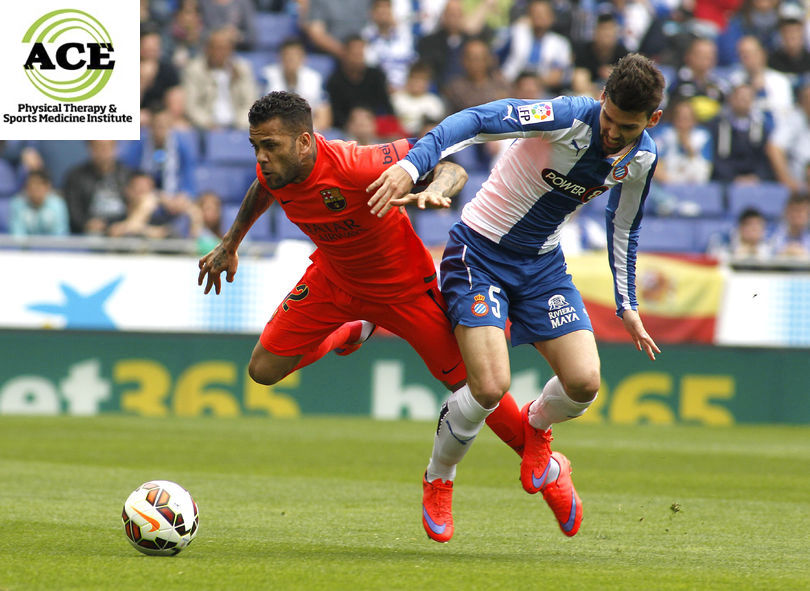MEDIAL COLLATERAL LIGAMENT (MCL) KNEE INJURIES

Tid Bits of Info
- Severity of the MCL tear is graded as Grade I, II, or III. Grade I is mild and Grade III is a complete tear.
- Initial treatment of a MCL injury follows the R.I.C.E. principles of acute injury treatment.
- Excessive force to the lateral (outside) aspect of the knee can lead to tearing of the MCL. This places a valgus stress on the MCL.
- The MCL has an attachment to the medial meniscus.
- Seek the advice and treatment from a Physical Therapist if you injure your knee.
The knee joint facilitates walking, running, jumping, and all sorts of movement, but it is also easily injured. Three bones connect at the knee joint, and these three bones are held together by four key ligaments. This design makes the knee joint particularly vulnerable to any direct contact to the knee or hard muscle contraction. If the knee is struck on the outside or lateral aspect with great force it produces a valgus stress or medially directed stress that can injure the Medial Collateral Ligament (MCL). Patients suffering from a damaged MCL can experience positive benefits by utilizing Physical Therapy as a part of the healing process.
Design of Knee Joint
The knee joint consists of the Femur from the top, the Tibia on the bottom and the Patella in the front. Each bone is held together with several ligaments which are leather-like structures that provide significant stability. The muscle structure surrounding the knee joint also provides dynamic support. The ligaments are leather-like and do not have the ability to stretch. If too much force is applied to the ligament, it can tear.
The joint’s design of rounded, half-moon like femoral condyles articulating on relatively flat tibial plateaus can easily be destabilized and injured. Some of the most devastating injuries occur without any contact, and they usually don’t heal on their own and in most instances require surgery. Contact injuries of certain ligaments, although debilitating for a period of time, heal on their own and do not require a surgical procedure.
Medial Collateral Ligament (MCL)
The MCL is one of the most commonly injured ligaments of the knee. If the knee is hit from the outside, or forced sideways, the MCL may be injured. The MCL can be damaged severely if the valgus stress is severe and due to its anatomic attachment to the medial meniscus the cartilage can also be damaged. In most cases, the MCL will heal on its own, but the cartilage does not in many instances. The patient will experience swelling, instability and pain. There will be point tenderness to the medial joint line area and possibly at the attachment sites of the MCL on the Femur and Tibia.
Physical Therapy for MCL Injuries
An extensive Physical Therapy program can play a vital role in recovery for MCL injuries. Patients suffering from MCL injuries will experience pain and instability at the sides of the knee, swelling and instability. Physical Therapist will examine the injured area and may request an MRI as part of treatment.
Phase One – Stability and Reduced Swelling
The first goal is stabilizing the injured area. Patients wear a stabilizing brace for a period of time to protect the joint from the instability. Crutches may also play a role during the start of treatment.
Physical Therapists will use modalities and exercises that help reduce swelling reduction and pain while enhancing the range of motion. The exercises will be linear and be performed with the brace on if the exercise is a weight-bearing activity. If the damage is severe, the core and entire involved lower extremity will lose strength secondary to dis-use atrophy.
The healing time required for this type of injury can range from a 2-8 weeks depending upon how severe the damage is to the joint. The patient’s progress will be assessed at each visit.
Phase Two – Strengthening Phase
When motion returns to nearly normal limits and the swelling and pain drop to very low levels or resolve completely, the strengthening phase of the rehabilitation process can commence. Physical Therapists help patients to strengthen lower extremities and the core through a series of strenuous exercises.
As the strength returns, the patient will begin agilities and possibly plyometric jumping to establish the explosive power throughout the involved lower extremity. When the patient is going to return to their normal activity level, they might be required to wear a supportive brace as a precaution and to add some stability to the joint.
Seeking treatment from a Physical Therapist does not require a visit to a doctor. If the patient’s knee is severely injured, an orthopaedic doctor should be involved in the treatment. If the injury is not severe a Physical Therapist who specializes in treating and rehabilitating orthopaedic injuries will be able to help the patient return to pre-injury lifestyle.

























